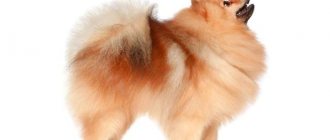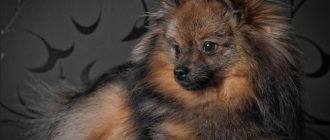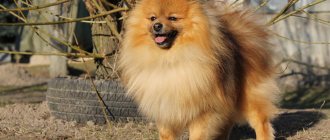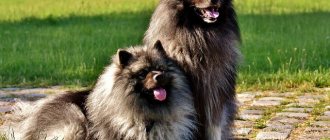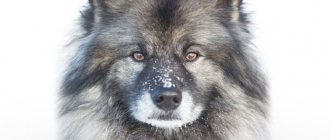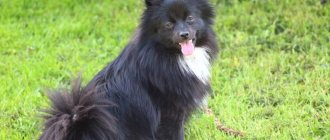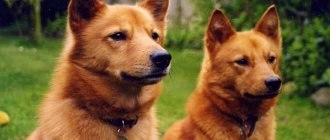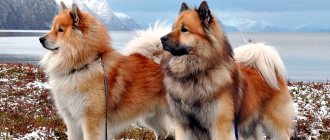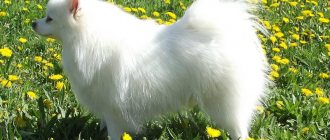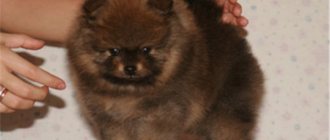The German Spitz is a breed whose history dates back about 2,500 years. Until now, in his homeland, he fulfills his main mission - guarding homes and participating in herding livestock. In our country, these dogs are better known as cute decorative pets, pleasing to the eye with fluffy fur and a fox-like muzzle. It is not surprising that small German Spitz dogs have taken over the whole world. But perhaps not everyone knows that there are several varieties of German Spitz - from fairly large ones to small, miniature ones.
Origin of the breed
Dog handlers have found plenty of evidence that Spitz dogs are one of the most ancient dogs on earth. In South Asia, Europe, China, and Egypt, images of animals were found that from a distance resemble representatives of the breed. The dogs' ancestors lived in different parts of the world, and were very popular among noble nobles. Many dog experts agree that wolves were close relatives of the breed, so babies, despite their tiny size, may experience behavioral problems.
The second assumption regarding the origin of the babies is that their ancestors could well have been northern dogs. The historical homeland of the breed is Germany, it was here that the standards for the entire group of dogs were developed. The first standard was created in 1899. Today they are good family pets who quickly find a common language with every family member.
Care
In the eyes of a puppy who has just arrived there, the apartment looks like an unfamiliar, alien world! Every careless movement can be dangerous for the puppy. To protect your pet from the dangers that await him and possible herbs, you should follow the recommendations. Purchasing a dog enclosure will be an excellent solution if the puppy is left alone in the apartment. This is his cozy corner, where there is everything necessary for waiting for the owners. The main thing is that the baby is safe and his games and pranks will not lead to damage to property, because boredom can make the baby chew wires or bite off a corner of the wallpaper.
To prevent the puppy from getting hurt, his play area needs to be fenced off
A comfortable bed and a tray with filling should be in the enclosure.
A bowl of water and a portion of food should be available to the dog. While waiting, you can put a bone from the veins. It is better not to leave toys and balls in the enclosure; the dog can bite off a piece of rubber and swallow it, and this is a foreign object in the stomach, which is very dangerous for the baby.
After a long wait, when the owner returns home, it is necessary to play with the dog and take it for a walk. You need to take a leash and collar, toys and treats with you. In damp, rainy weather, you can put a Bolognese overall on your puppy - it will protect the puppy’s coat from contamination, and you won’t have to wash the baby, but just wipe his paws with a damp towel.
Playing with a puppy, communication and care will be an excellent incentive for a companion dog to grow up. Loud barking and prolonged howling occurs in unbalanced, neglected dogs.
Diet features
The dog's miniature size does not allow it to swallow large pieces of food. Meat and vegetables must be cut into pieces. Chicken, lamb or beef should make up 70% of the diet, vegetables and cereals - 30%. Buns, sweets, and cakes should not be fed to Spitz dogs.
During the period of active growth of the Spitz from 4-8 months, it is necessary to add vitamins to the diet for puppies of small breeds. During the period of active molting in a dog, brushing and adding sea fish to the diet will help the body cope with the change in coat.
During the molting period, add sea fish to your pet's diet.
A fur coat is an indicator of a healthy pet and proper feeding; a lack of vitamins A, E, F will affect the coat - it will become dull and mat.
Hygiene
An active and playful dog with sparkling eyes and fluffy fur requires the owner’s time not only for games, but also for care:
- You need to brush your dog twice a week.
- Wash with shampoo – once every three months.
- Wipe your eyes and inspect your ears – once every three days.
- In spring and early summer - treat your dog for ticks.
Description of the breed
The small German Spitz has a very attractive exterior: its muzzle is slightly pointed, like a fox's, which gives it a smiling expression. An incredibly beautiful fur coat cannot help but attract attention. Main appearance characteristics:
| Appearance | Characteristics |
| Head | wedge-shaped, small in size, with a pronounced stop. The nose is rounded, small, black for all color types except cream and brown; |
| Lips | smooth and tight, fit tightly, hiding white, even teeth. The jaws are full-toothed, well developed, scissor bite; |
| Cheeks | round and smooth, eyes of medium size, almond-shaped or oval. The eyelids are pigmented, black in all colors except chocolate; |
| Ears | erect, triangular in shape, set high. The neck widens towards the bottom, there is a slight bend, of medium length. There is a collar on the neck that is characteristic of the breed; |
| Frame | with high withers that flow smoothly into a straight and strong back. The loin is short and wide, the chest is well developed and deep. The stomach is well tucked; |
| Tail | medium length, set high, evenly pubescent. There is a crease on the back, maybe 1 or 2 curls; |
| Paws | Muscular and well-furred, widely spaced, strong. There are characteristic pants, paws in a ball. |
The animal's movements are confident and free, clear. The skin is dense, elastic and smooth. The head, paws, ears and the front side of the limbs are completely covered with hair. The undercoat is thick and fluffy, the top, axial hair is long.
How to choose a puppy
Since German Spitz puppies, especially the dwarf variety, are very popular, the rate of breed defects is high.
Often the Pomeranian species is crossed with small individuals of the Spitz.
Such dogs are sold cheaper, without brands and documents. The reliability of breeders is important.
The largest varieties of the German Spitz, the Keeshond and the Great Spitz, are vigilant and capable of protecting their owner.
When purchasing a puppy older than 4 months, you should know: at this time the dog sheds, so the coat will not look perfect.
A fully “adult” fur coat will be formed by about a year.
Should be considered:
- males are more independent, females are more affectionate and obedient;
- for breeding it is better to choose a large girl, especially in small species;
- signs of the quality of the breed - proportional square build, tail adjacent to the back, erect ears, pointed muzzle, “smile”, scissor bite;
- the coat is shiny, thick, without dandruff;
- the puppy should be cheerful, active, curious, and willing to take treats.
The color of the representatives of the breed varies.
Dogs found:
- zone-gray (Wolfspitz, medium, small, dwarf);
- plain black, brown, orange, white (large, small, dwarf), white paws are considered defective;
- cream, cream-sable, black-and-tan, orange-sable, spotted with a basic white color.
The German Spitz quickly becomes attached to the family and does not tolerate separation and loneliness. A long-neglected dog can turn into a spoiled aggressive creature
Dimensions: depend on the type. The average height at the withers is for:
- Wolfspitz (Keeshond) 49-55 cm;
- large (grossspitz) 46-52 cm;
- medium (Middle Spitz) 34-38 cm;
- small (Kleinspitz) 26-29 cm;
- dwarf (Pomeranian) 20-22 cm, not lower than 18 cm.
The main differences between the popular Pomeranian and other Germans are:
- height at the withers no higher than 22 cm;
- pronounced “felt” structure of the coat with a padded thick undercoat (other German Spitz have a less dense undercoat);
- a more convex forehead, a pointed but slightly snub nose (in other species the nose is longer and sharper), a shortened muzzle.
The German Spitz is quite easy to care for. It is enough to comb it once every two weeks
Pros and cons of the breed
Even such a cute miniature breed as the Small German Spitz has its strengths and weaknesses. They must be taken into account, especially if you keep the dog in an apartment.
- beautiful exterior;
- good-natured and calm disposition;
- gets along well with children and other pets;
- excellent protective instinct;
- small size allows you to transport your dog compactly;
- unpretentious in nutrition;
- are toilet trained at home.
- loud barking with or without cause;
- notes of jealousy and selfishness in character;
- complex grooming;
- It is not advisable to let your dog off the leash on the street;
- high cost of a puppy.
If your pet has a conflict with a yard animal, he will never pay attention to his small size: he will boldly get involved in a fight, which the owner will have to break up. Thick fur constantly sheds, which creates discomfort for all family members: it sticks abundantly to clothes, furniture, and remains on the carpet.
Health
Characteristic diseases
This is a naturally strong dog. Among the diseases that Spitz dogs are susceptible to:
- subluxations and dysplasia of joints;
- problems with the thyroid gland;
- obesity;
- conjunctivitis, in old age - retinal dystrophy, cataracts , glaucoma;
- colitis, gastroenteritis (with poor diet);
- allergies , dandruff, eczema;
- tartar.
You can learn more about obesity in dogs from the article
The German Spitz feels great both in a city apartment and in a country house
Even the German miniature Spitz-Pomeranian requires regular exercise, but large species require walking.
Each pet also needs a balanced diet and attention from the owner.
Vaccinations
At the age of 2 months, the puppy must be vaccinated against viruses (enteritis, hepatitis) with revaccination after 2 weeks.
At 2.5 months, a vaccination against canine distemper is given, with revaccination at 6-7 months.
The rabies vaccine is given to dogs no earlier than 8 months.
Information about vaccinations is entered into the dog's card.
The further schedule is drawn up by a veterinarian, but before each injection it is necessary to drive away helminths, and after vaccinations, quarantine must be observed until an immune response is formed (up to 20 days).
German Spitz in a flower garden
Peculiarities
The Small Spitz has a cheerful and mischievous disposition, loves to play and can frolic throughout the day. He is inquisitive and interested in everything around him. Despite its size, the Spitz is an excellent guard, thanks to its acute hearing. The baby is patient and allows even the smallest children to play with him. Only if he is hurt is the dog able to snap back or show aggression. The Spitz is very emotional, loves attention and affection, quickly grasps all commands on the fly and is easy to educate and train.
The dog does not tolerate loneliness well and it is better not to leave him alone for a long time. It is advisable to start socialization as early as possible, as the dog may be intimidated or afraid of loud noises and other things. Animals show caution towards strangers, but without aggression. The Spitz easily gets along with absolutely all pets: cats, dogs, rodents, birds. Their devotion to their loved one is enormous: the dog becomes very attached and has difficulty withstanding a change of owner.
Jealousy is inherent in kids: it is important for them to have a lot of attention and affection, otherwise selfishness breaks through in their character. If Spitz dogs don’t like something, they will openly tell everyone about it, even in front of strangers - loud and ringing barking should be taken into account when choosing a puppy for an apartment.
Application
In the past, large species were considered weapon animals and were used in hunting.
Today, all Spitz dogs are well socialized and are suitable for living in a city apartment.
They become attached to their family and do not tolerate separation and loneliness well.
A long-neglected dog can turn into a spoiled, aggressive creature.
An artistic dog can learn some tricks that will entertain him and his owner.
Good at agility .
Nutrition
A small puppy should be fed up to 4 times a day, and an adult dog – 2 times and no more. Ideally, the feeding time will be the same every day - this is the only way the dog will not beg and overeat. Dry balanced food should be premium or super premium; holistic food is not suitable. If your choice is a natural menu, it should contain the following components:
- boiled lean meat: veal, chicken, turkey, beef;
- cereals: rice, buckwheat, rolled oats;
- boiled and raw vegetables;
- seafood;
- fruits;
- fermented milk: cottage cheese, kefir.
Your pet must always have access to clean drinking water. It is forbidden to feed a dog from the table - “human” food is higher in calories, and this breed is prone to obesity.
From security guards to lap dogs
The study of the remains of lake and turf dogs found in central Europe gave reason to consider these animals as the ancestors of modern Spitz. It is believed that this breed has been around for 2,500 years. The first mentions of these dogs can be found in manuscripts of the fifteenth century. Ancient descriptions indicate that over time their exterior has not undergone major changes.
Initially, Spitz dogs were used as guards for sheep herds and household property. They also scared away and caught small rodents. Mostly these dogs were kept by ordinary people. The situation did not change until the upper strata of society noticed the loudly barking but very beautiful dogs. The nobility wanted to keep the Spitz with them and made them pets.
In the eighteenth century, German breeders, and then breeders from other countries, intensively set about breeding smaller representatives of the breed and obtaining different shades of wool from them. This is how five varieties of the breed appeared.
An obedient pet is a well-mannered pet
German Spitz have a pronounced dominance, for which they are nicknamed “Napoleons”. If you don't start training them as early as puppyhood, the situation can get out of control. Any indulgence on the part of household members over time risks turning into a bad character trait for the pet. Moreover, these small dogs need to be raised in the same way as large ones, showing firmness, perseverance and methodicality.
Spitz dogs are endlessly in love with their owner and are happy to please him. Therefore, training such pets is a pleasure. They quickly remember commands and love to cope with complex tasks. Dogs can be taught not only to fetch a ball and jump over low barriers, but also to perform various tricks. These animals often participate in circus shows, performing tricks and funny acts.
Multicolored miracle
The characteristics of the description of Spitz dogs of the small group also include their colors. Few breeds can boast such a variety of coat colors.
Breeders have bred many color variations of Spitz dogs. However, the FCI standard adopted pure black, zone-gray, pure white, white-red, cream, red and brown colors of varying intensity. Three-color coat colors are also allowed, when spots of the above shades are evenly distributed on the main white background.
Little ringing defender
Instincts from the past and excellent hearing make small Spitz dogs excellent watchdogs. Their vigilant, wary and confident nature allows them to be the first to notice strangers and announce their approach with a ringing bark.
But it is barking that can become a stumbling block in communicating with a Spitz. Every time the dog will react loudly to any irritant, which can infuriate even the most patient owner. Therefore, many consider these pets to be intrusive and obnoxious.
Being suspicious, these dogs do not favor either guests or the owner's friends. With good upbringing, they will not rush at them, they will just stand in the way, because such dogs do not lack courage. Whether this is arrogance or a manifestation of devotion and protection is up to the owner to decide.
Standard
The sable color is quite common, so it is not surprising to see a puppy of this color. The most common breed to see is a red sable Spitz with black tips. Spitz also comes in orange sable, cream sable and gray with black tips. All these varieties belong to the sable color, which is also called zonal.
The intensity of this color can be distributed evenly or vary slightly in color. According to the standard, a dark muzzle is acceptable.
The most popular sable-colored Spitz is wolf.
Wolf
Breeders have the following requirements for this species:
- Coat color: gray with a hint of silver.
- Guard hairs: The tips of the fur are black.
- Eyes: A clear black line around, the pattern extends from the outer corners of the eyes and extends to the bottom of the ears. Eyebrows resemble shrikhs.
- Mane and shoulders: These are the areas where the coat is the lightest.
- Forelegs and hindfeet: There are no black spots on the lower part, but there may be streaks directly above the phalanges.
- Tail: The tip is pure black. The inner part has light and silver shades, like the “pants”.
Any deviations from the standards are considered defective.
Genetics
In order for a puppy of this color to appear in the litter, the parents must have the following genetic formula: ayauV-C-D-E-kk.
Sable puppies
It is the ay gene that is responsible for the spread of pigmentation throughout the pet’s fur. Recessive genes kk are catalysts for the formation of the main color, E is a dominant gene that forms the distribution of dark pigment on the tips of the coat throughout the animal’s body.
Cost of a sable spitz
There is no definite answer about the cost of a sable Spitz. The price is influenced by a number of factors:
- pedigree;
- sexual characteristics;
- shades of fur.
Fur color does not affect cost as much as other factors, but gray sable puppies cost less than cream and tan puppies.
Sable Spitz: puppies
Typically, prices for sable Spitz vary from 10 to 200 thousand rubles.
You can buy a puppy from one of the popular and trusted nurseries:
- Maeby Faye (Penza);
- Silver Amulet (Saratov);
- From a cloud over the Neva (St. Petersburg) and in others.
It is best to purchase a pet from nurseries officially registered with the RKF-FCI. This will allow you to be confident in the quality and thoroughbred of the animal.
